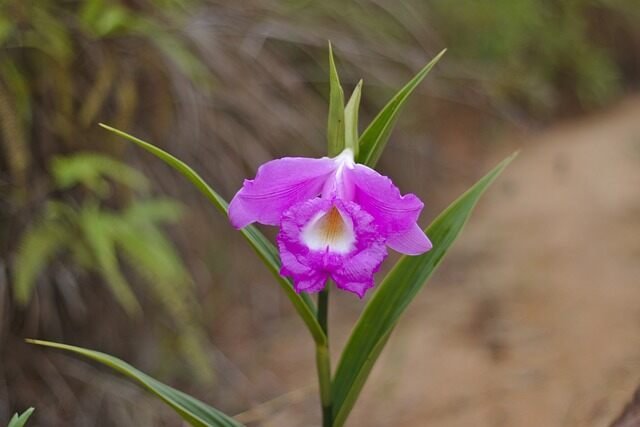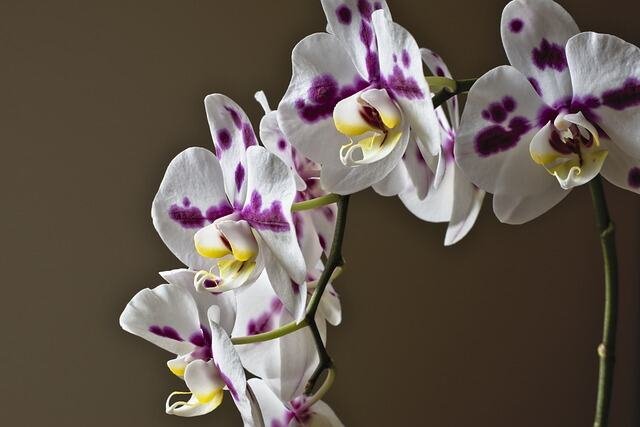Today, we’re going to do something a little bit different. We are not going to talk about what happens when we’re going to talk about what to do when your orchid falls out of its pot. Why would an orchid fall out of its pot? Well, I’ll tell you, there are multiple ways and instances in which your orchid can simply fly out of its pot, and I’m going to tell you what to do about it because you should actually do something as fast as possible. And the main character today is this beautiful Cattleya type orchid that I’ve been wanting for a long time. Let us begin.
Now, this orchid is already potted up, and this is because I received it a couple of days ago, and I had to act then and there. And I will explain to you why then. I already filmed that, but first let’s start with how can an orchid just fall out of its pot? First off, do you have pets, especially of the feline kind? Well, as I understand, cats sometimes can walk in between the pots and sometimes have a tendency to just slap pots and plants. And I’m not a cat owner, but I’ve read enough articles and I’ve heard enough about it to know that cats sometimes bump things over just for fun. That can happen. You might also have pets of the avian kind. As you know, I have my birds which are in the aviary. Now they like to try and land on flower spikes or long leaves. Hence, the orchid ends up on the floor out of its pot.

Another sure way to get an orchid out of its pot is by snagging it with your clothes, especially those beautiful Phalaenopsis that have long and archy flower spikes. I should show you one of those. Right there she is, my pride and joy. Her flower spikes are absolutely gorgeous, if I don’t position this orchid in a secure place, I can definitely brush against these flower spikes, they can get snagged in my clothes, and the orchid would be on the floor. Also, because this orchid is top-heavy, I have it in a very heavy pot. Otherwise, it would end up on the floor as the flower spikes grow. And we talked about this, I think in this series, what happens when you don’t stake your flower spikes? Well, one of the things that can happen is your orchid is out of its pot. Also, if you have it next to a window and you have a curtain or something, and then there’s a gust of wind for whatever reason or a draft, your curtain can again get trapped in the flower spike. And then as the wind moves the curtain around, it can bump over your orchid. Causes are so, so many. I’m sure I can come up with a few more causes that I’ve experienced along the years. It’s very frustrating.
But the cause that we will take care of today is that of some really tough transport. Sometimes, no matter how much nurseries pack our orchids as stable as possible, transport can be quite rough and bumpy. Have you ever seen those reels in which parcels are kind of thrown around? Yeah, sometimes that can happen. Sometimes they can just fall, not necessarily be thrown around. Things happen during transport, and sometimes our boxes are either positioned upside down, either they’re bent, and sometimes our orchids are simply jiggled inside so much so that they completely come out of their pot. And especially if you have an orchid potted only in bark, which is a great medium, but if it’s chunky, it doesn’t really stabilize the orchid in the pot, then you can have all the bark in one corner of the box and the orchid in the other corner. This is what happened to this orchid. Something happened during transport, and this orchid was not in its pot anymore, even though the person who sent it to me packed it very, very well. It was even packed in its own wrapping paper. It still got out of its pot.

Now, it is very important when you have such a situation to act as soon as possible. So, I’m going to refer you to past Danny which repotted the orchid for her, which is actually me. It’s weird. Yeah, I’m going to explain to you as I repot the orchid why it’s important to act as fast as possible if you have an orchid out of its pot. Alright, so here is what we are dealing with: a Cattleya-type orchid which arrived something like this, completely out of its pot. Now, the medium was pretty much everywhere. Even if I tried to put it back, it wouldn’t have been exactly like it was before. It wouldn’t have been stable in any way. It was also bark, and it didn’t look to be very fresh anyway. So, immediately as I saw the orchid, I put some more water. I did that one hour ago. But my main concern was to maintain these roots humid. The problem with orchids falling out of their pot is that their root system suddenly will experience a much, much drier environment. And typically speaking with orchids, that is a no-no. Their roots cannot adapt suddenly to these types of swings in the moisture around their roots. Yes, they are adaptable generally speaking to more droughty conditions, but these conditions usually happen gradually. The roots that grow adapt as they grow to the surrounding environment. The roots that are already grown have a much harder time adapting to a different type of environment. And when I say environment, I don’t mean necessarily the type of material we’re using, but the humidity or lack thereof that it generates. So, all of a sudden, our orchid is not placed like it used to be, so the medium does not offer the same amount of humidity. What happens especially with Cattleyas, but not only with finer-rooted orchids as well like Oncidiums, Dendrobiums, less with Phalaenopsis, I will agree, less with Vandas, but generally what happens if the roots are exposed to too much air all of a sudden is that those roots will desiccate very, very fast. And when you will rewater the orchid, pretty much you will speed up the breaking down or decomposition process. And in no time, you’re going to find yourself in a root rot situation. And you’re going to wonder what happened, what did you do wrong? You pretty much didn’t do anything wrong. But to prevent that instance, we need to address the roots right away.

So, what can you do right then and there? You can repot the orchid back, gather all the bits and pieces of medium. If it’s fresh, if it’s not fresh, you can use a different type of medium. You can just repot the entire orchid if the medium is old. It is your choice. But get that orchid into medium. If you don’t have medium at hand, if you think you’re going to be a few hours late, do what I did: put the orchid back in the pot, whatever medium you still have left. As much as possible, I placed mine like this and just put water in there, soak the roots, and maybe leave it in a little bit of water while you go to the shop and get yourself some bark or whatever medium you prefer. It is really, really important that you do that with these orchids. Trust me. And when you’re home, do a repot as soon as possible. Even at night, it’s fine. If you cannot do it right away, put water here, keep the roots wet, not submerged in water, but exposed to a little bit of water so they can pull that water and not desiccate. It is so important to not let them desiccate, and they desiccate really fast.
Now, what we are going to do today is completely repot this orchid because I want to put it in my own type of medium. So, I kept it moist for the past half an hour to an hour, and now it is time to remove all of this old medium, which looks pretty old, to be honest. So, I will go ahead and remove this sphagnum moss, which I do believe is quite old. By the way, my orchid is a pretty young orchid. Not a seedling, I wouldn’t necessarily call it a seedling, but it is pretty young. So, I’ll go ahead and remove as much of this medium as possible and also cut away any dead root if I see any. Pretty much go about it like a normal repot.
Alright, here we are. I rinsed the roots of my orchid. Now, what I want to do is spray some hydrogen peroxide 3% only on the root system. I do this because many of the times I do find snails in brand new orchids, and snails, if left unattended, they can definitely destroy the brand new root tips. I’ve lost quite a few orchids to snails. I’m not taking any chances. For the past ten years or so, the past decade, I’ve been using hydrogen peroxide 3% that you can find in the pharmacies sprayed on the root system whenever I repot a new orchid, and I have never had snail issues ever again after dealing with them for a year. It was horrible. You don’t need to rinse the soap. You can put it in a spray bottle like I did for ease of use. If you’ve ever had issues with snails and no pellets worked because, trust me, I tried pellets as well, then hydrogen peroxide 3% is the way to go.
Right. So, I’m going to be using a combination of bark and sphagnum moss. This is what goes well for epiphytic orchids generally in my area. I can also get away with full-fum moss. However, I’m moving house soon, and I might actually have a very different environment in that house. It’s quite different. So, I’m just going to go with a safe bit just to see how my roots grow there. I am using a 3-inch repotme pot, which is one of the greatest pots of life. It is UV protected. This is not doing that. So, I’m using one of these pots, and I’m putting sphagnum moss at the bottom just to absorb water that maybe falls in the tray. Yes, I’m a little extra. You can go ahead and premix everything in a separate bowl or purchase an already made mix. It’s fine. I’m extra like that. I like to fully customize my pots.
Then I will put some bark around, and then again some sphagnum moss. I’m pretty much alternating the medium here to create an evenly moist environment. That is what I want to obtain. This way of arranging my mix also works well with slotted pots because it further prevents layering. What I mean by layering is the uneven moisture distribution in the pot. Sometimes, if you don’t have very water-absorbing materials in your pot and you don’t even have ventilation splits, you will notice that most of the moisture will be at the bottom and the top will be very dry. Well, if I arrange my potting mix like this, I don’t seem to have that issue.
I’m also going to be using some slow-release fertilizer. Why not? Cattleyas do really enjoy some slow-release fertilizer. Just a few beads. I’m using Osmocote. I don’t have the MSU. I cannot import it in the EU just yet, but Osmocote is a good option as well. And I’m going to finish off with a layer of bark. Yes, I’m extremely extra, but in my environment, the wet sphagnum moss, if exposed to light, it does grow cyanobacteria, and that is not nice. It stinks. It produces kind of toxic byproducts that affect root tips and little stems. So, I like to prevent cyanobacteria by placing a non-water-retentive material that can shade the first layer of sphagnum moss, and then everything will go into a decorative pot to shade the sides of my pot.
I’m very curious to see if in my new house I will have cyanobacteria issues. I suspect I will, but yeah, I am going to experiment, right? So, my orchid is now potted. It will probably sit in this decorative pot. But first and foremost, I need to water it. I need to maintain the roots again moist because this medium was dry. I used it dry. So, I’m going to go run water through the pot thoroughly at the sink.
And here we are today, a few days later. I can see through the pot barely a root. I can see it’s still moist and it’s not brown or anything, so I think we managed to intervene in time so that the roots did not desiccate or suffer due to the lower humidity all of a sudden. So, I do believe everything will be just dandy with the orchid. If you don’t know how the orchid looks like, I’ll put a picture. I had it in the past. Not sure if this one will be identical to that one. That one was a pinker variety, but the Vanda Apple Blossom is one of the most gorgeous orchids you can have. You can sometimes find it in flower shops. It is an older hybrid. Red nurseries should have it. And do not be afraid of it if you’re a beginner. It is just as easy to care for as any other Cattleya.



